Monday, October 31, 2016
School Life Monday:
How Adverts Refuse To Sell Us What We Want
Adverts know us well and therefore tease us with promises of love, friendship, calm and success – but then go on merely to sell us things we don’t particularly need: like bars of chocolate or sports cars.
Labels:
capitalism advertising,
school of life
Sunday, October 30, 2016
Saturday, October 29, 2016
A Close Look at the FBI's File on Wu-Tang Clan

(to see more pages from the file go to the original article)
This article appeared in the October issue of VICE magazine.
The FBI has always had a hard-on for gangsta rap music, specifically the creative forces behind the genre's most iconic and provocative hits.
Back in 1989, for example, the bureau's assistant director of public affairs sent a letter to Brian Turner, the president of Priority Records, home to NWA, vehemently objecting to the lyrical content of the group's now-infamous protest song "Fuck tha Police."
"Law enforcement officers dedicated their lives to the protection of our citizens, and recordings such as the one from N.W.A. are both discouraging and degrading to these brave, dedicated officers," wrote the FBI's Milt Ahlerich. "Music plays a significant role in society, and I wanted you to be aware of the FBI's position relative to this song and its message. I believe my views reflect the opinion of the entire law enforcement community."
More than 20 years later, the FBI went a step further and directly linked rap music and "gangster Rap culture" to an increase in gang membership and crime, an unsubstantiated claim made in a 2011 report produced by the FBI's National Gang Intelligence Center.
"Law enforcement in several jurisdictions also attribute the increase in gang membership in their region to the gangster Rap culture, the facilitation of communication and recruitment through the Internet and social media, the proliferation of generational gang members, and a shortage of resources to combat gangs," the report said. "Gangster Rap gangs, often comprised of juveniles, are forming and are being used to launder drug money through seemingly legitimate businesses."
For decades, the FBI has probed legendary musical artists, including Jimi Hendrix, the Doors, the Beatles, and the Grateful Dead. The bureau even launched a separate investigation into "Louie Louie" by the Kingsmen, looking into whether the unintelligible lyrics violated obscenity laws.
But the FBI's investigation of black artists—particularly rap groups—stands out. VICE recently filed Freedom of Information Act (FOIA) requests with the FBI for its files on some current mainstream rap and rock groups (including Slaughterhouse, Army of the Pharaohs, Blink-182, and Radiohead). While we wait for those records to trickle in (if they exist), it's worth revisiting one of the most notorious case files in the FBI's "popular culture" collection: that of Ol' Dirty Bastard, and Staten Island hip-hop superstars Wu-Tang Clan.
Between 1999 and ODB's death in 2004, the FBI worked alongside the New York Police Department to investigate Wu-Tang Clan for a wide range of alleged federal crimes. They never filed any charges, but the FBI devoted substantial resources to the inquiry in an effort to take the Wu down. In 2012, in response to FOIA requests, the FBI released a 95-page file on ODB and "WTC," which is how the agency referred to the group. The inflammatory allegations leveled in the file (drug dealing, gang ties, murder) have been written about in the past, but little attention has been given to the scope of the FBI's investigation and how it began.1. This page is an electronic communication that was used to open the case. It indicates the investigation originated in New York and stemmed from a referral by the NYPD, which was investigating the murders of two drug dealers. The police suspected that RZA of Wu-Tang Clan had ordered them, with Raekwon's complicity.
2. This "281F" classification code shows that the FBI had labeled Wu-Tang Clan as a "major criminal organization."
3. "OC/DI" is an FBI acronym for organized-crime/drug investigations.
4. These are FOIA exemptions, which the FBI uses to protect an individual person's privacy. In this case, the privacy exemptions protect the NYPD detective who requested assistance from the FBI and the person(s) who the agencies believed to have "funded" Wu-Tang Clan's alleged criminal acts.
5. The last paragraph on this page contains the most explosive bits. NYPD detectives sought the FBI's assistance in order to mount a RICO prosecution against the Wu-Tang Clan "organization." Congress passed this legislation, the Racketeer Influenced and Corrupt Organizations Act, in the 1970s to make it easier for federal prosecutors to dismantle Mafia families.
The file notes that Ben Campbell, then the assistant US attorney for the Eastern District of New York (the office that prosecuted infamous Cosa Nostra figures and al Qaeda terrorists), "is willing to seek prosecution of the WTC." In other words, according to these files and the FBI's and NYPD's preliminary investigation, Wu-Tang Clan, a highly regarded hip-hop group that had sold millions of records, was also a criminal organization engaged in conspiracies such as drug running and executions.
6. This page shows that the FBI requested permission to travel to Allentown, Pennsylvania, where the "RA" (resident agency) would "provide and compare information relating to the drug business of the Bloods street gang and the Wu-Tang Clan."
7. This is arguably one of the most important and overlooked pages in the FBI's Wu-Tang Clan file. It reveals that in April 2000, less than six months after the FBI launched the probe, the bureau sought the assistance of the New York FBI's FAST Unit in investigating the group and "the businesses or entities controlled by the WTC." The inclusion of the FAST Team underscores the seriousness of the investigation. It's impossible to find anything about the FAST Unit through a simple Google search. But with assistance from our FOIA attorney, Jeffrey Light, we discovered what "FAST" meant: financial analysis strategic targeting.
The team was referenced during a June 25, 1990, Senate subcommittee hearing about New York's "high-intensity drug trafficking areas." According to a transcript of the hearing, David J. Ripa, the assistant regional commissioner for enforcement at the US Customs Service, Department of the Treasury, testified that the FAST Unit was developed "as part of the New York region's anti-money laundering investigations and intelligence strategy... in coordination with the mission and objectives of [the US Treasury's] FinCen [Financial Crimes Enforcement Network].
"This team reviews operational case reports, seizures, and evidence and utilizes a vast quantity of sources to develop major targets for investigation and/or interdictory pursuits. The FAST team, which is comprised of Customs analysts, agents and inspectors complemented by investigative resources from IRS, HHS [United States Department of Health and Human Services], DEA, Brooklyn District attorney's office, New York State Police, and the Manhattan District attorney's office, provides a mechanism for target identification, preliminary evaluation, intelligence collection, and dissemination to a variety of US Customs operational investigative groups and multiagency task forces—that is, southern district task force, Long Island task force, and Customs/New York State Police task force."
8. The second and third pages of this part of the file go on to identify all of the businesses incorporated by Wu-Tang Clan, including a management and production company, record label, and clothing line. It's clear the FBI was suspicious that Wu-Tang Clan was laundering drug money through these businesses. Indeed, the last paragraph on this page says Campbell, the assistant US attorney for the Eastern District of New York, requested the FAST Unit's assistance. It also notes that a special agent who's assigned to "RIS" (which we suspect may be a mistyped reference to the IRS, as no agency official was able to elaborate on what RIS is, and it is not referenced in any other documents) was tasked with "identifying the flow of monies through the assets and entities controlled by the WTC and will work in conjunction with the FAST Unit."
9. The mention of the New York FBI's C-30 squad here is noteworthy. According to a Justice Department Office of the Inspector General report, Squad C-30 was part of a violent-crime task force whose mission is to "disrupt and dismantle the activities of identified FBI National Gang Strategy violent street gangs that operate within the five boroughs of New York City."
10. In July 2004, the FBI closed its "281F" case file and investigation, "major criminal organization," against Wu-Tang Clan, noting that NY FBI's Squad C-30 would handle the probe. Moreover, the FBI file says a special agent who assigned it the "267C" classification code, which is a drug-related homicide, was in charge of the case.
Wu-Tang Clan's FBI file resurfaced again in late 2015 in the case of a pair of Staten Island drug lords—brothers who were convicted on drug charges, one of whom was also found guilty for the murders of the drug dealers that the NYPD and FBI suspected RZA and Raekwon had ordered. As the sentencing of the brothers approached, a lawyer for one of the accused said in court that his client, Anthony Christian, wasn't responsible, and he referenced the FBI's five-year investigation into Wu-Tang Clan.
"These [FBI] reports seem to suggest someone else was liable for those murders. I'm not suggesting that Wu-Tang committed these crimes. The FBI did," lawyer Michael Gold told the Staten Island Advance. "What I'm trying to ascertain is their stated belief in an official file that Wu-Tang ordered this homicide."
Despite a nearly yearlong effort by Gold to get federal prosecutors to reopen the investigation into the alleged role Wu-Tang Clan, RZA, and Raekwon had in the murders, Brooklyn federal judge Eric Vitaliano rejected the defense's appeals. Last July, Christian was sentenced to life in prison on murder and other charges.
And with that, RZA, Raekwon, and Wu-Tang Clan were cleared. The lesson here for the FBI, NYPD, Christian, and his attorney? Wu-Tang Clan ain't nothing ta fuck wit.
Labels:
FBI,
Wu tang clan
Friday, October 28, 2016
Nadya, Pussy Rioting again!
"Make America Great Again"
#PussyGrabsBack #NastyWoman (!) Because YOU decide elections and if we get together, we could blow this shit up, take action and reverse this erosion of rights. Because fuck it.
- - - -
Written passionately by Ricky Reed, Nadya, Tom Peyton
Produced by Ricky Reed
- - - -
Music video is directed by Jonas Akerlund
Style: B Akerlund
Make up : Ozzy Salvatierra
Hair : Patricia Morales
Special effects make up : Jerry Constantine
- - - -
Be Pussy Riot. It's fun.
Twitter: https://twitter.com/pussyrrriot
Instagram: https://www.instagram.com/nadyariot/
Facebook: https://www.facebook.com/wearepussyriot
Join Lady Parts Justice: http://www.ladypartsjustice.com/
- - - -
What do you want your world to look like?
What do you want it to be?
Do you know that a wall has two sides?
And nobody is free?
Did your mama come from Mexico
Papa come from Palestine
Sneaking all through Syria
Crossing all the border lines
Let other people in
Listen to your women
Stop killing black children
Make America Great Again
Could you imagine a politician
calling a woman a dog?
Do you wanna stay in the kitchen?
Is that where you belong?
How do you picture the perfect leader
Who do you want him to be
Has he promoted the use of torture and killing families
Let other people in
Listen to your women
Stop killing black children
Make America Great Again
Labels:
america,
Dump,
Music,
Politics,
Punk,
Pussy riot,
revolutionary
Thursday, October 27, 2016
Elizabeth Warren is the US president we need,
but can’t have – this time
from The Guardian:
She’s a champion of workers’ rights, and a thorn in the side of Wall Street. What a tragedy that the Massachusetts senator isn’t on the ballot paper
She’s a champion of workers’ rights, and a thorn in the side of Wall Street. What a tragedy that the Massachusetts senator isn’t on the ballot paper
If only it were Elizabeth Warren on the brink of taking the White House. At a New Hampshire rally, tearing remorselessly into the misogyny of Donald Trump, Warren was a reminder of what could have been. The US presidential election has not, to say the least, showcased the best of the US: the country of the anti-slavery movement, the suffragettes, the labour movement and the civil rights movement. Instead, the racism and bigotry that infests significant swathes of the country has been distilled into human form and paraded for a global audience. Hillary Clinton is the only means to stop the victory of a candidate who could send the last remaining superpower hurtling into a political death spiral. But although the Bernie Sanders movement has shifted the Democratic party to the left, let’s not pretend a Clinton presidency would provide an alternative to a society rigged in favour of Wall Street and corporate America.
Warren, on the other hand, has been a determined champion of Main Street. She has passionately campaigned against Obama’s proposed Trans-Pacific Partnership deal, which would grant corporations the ability to sue elected governments in secret courts to stop policies they don’t like. She is unlikely to be invited to give lucrative speeches to Wall Street firms: she has castigated the failure to prosecute bankers for the financial crisis, and has supported a campaign to “Take On Wall Street” with a raft of reforms. It took Warren’s campaigning zeal to create the Consumer Financial Protection Bureau, which provides some protection for consumers in the financial sector.
She’s a champion of workers’ rights, campaigning for those employed in the “gig” economy to get basic employment protections and social security. She has fought for a genuine living wage, arguing that the minimum wage would have risen to $22 an hour if it had increased at the same rate as productivity. She has demanded action to crack down on corporate tax avoidance, passionately making the case that “there is nobody in this country who got rich on his own. Nobody.”
She has courageously embraced the Black Lives Matter movement, demanding reform of the police to stop the unjust killing of black Americans. She has co-sponsored a bill to repeal the authorisation for the Iraq war – which Clinton, of course, voted for – and has demanded the return of US troops from Afghanistan. And she backed equal marriage for same-sex couples before Clinton belatedly converted to the cause.
Not that Warren is perfect: her sympathy for Israel’s military offensive in Gaza is, to say the least, a disappointment. But Warren is unapologetically in the tradition of courageous Americans who confront elites and stand up for the rights and freedoms of the average citizen. She has, naturally, been abused by the horror show that is Trump: because she claims Native American heritage, he calls her “Pocahontas”.
Despite the earlier hopes of many American progressives, it will not be Warren in the White House next year. But both Warren and Sanders have risen to prominence for a reason. Growing numbers of Americans are disenchanted with a society where so much wealth exists alongside so much insecurity. Trump – although sadly not Trumpism – will almost certainly be defeated at the polls by the decent American majority next month. But President Clinton may swiftly find herself under pressure from an emboldened progressive movement – one with very little patience.
Labels:
elizabeth warren,
Politics
Wednesday, October 26, 2016
Nadya of Pussy Riot
Song Straight Outta Vagina inspired by the idea that
‘female sexuality is bigger than any populist megalomaniac’
from The Guardian
Pussy Riot have released a song celebrating the vagina, in an unashamed feminist riposte to Donald Trump and his boast that when he meets beautiful women he “grabs them by the pussy”.
The Russian punk band’s latest video Straight Outta Vagina, released on Tuesday, features Pussy Riot’s Nadya Tolokonnikova wearing white clerical robes and trademark balaclava, plus a chorus line of men and women sitting in toilet cubicles and standing at urinals. There is also an inflatable duck.
In typically provocative style, the video includes the lyrics: “If your vagina lands in prison, then the whole world’s going to listen.” And: “Don’t play stupid, don’t play dumb, vagina’s where you’re really from.”
Tolokonnikova said she recorded the song in February with the US musician, guitarist and producer Dave Sitek, whom she described as “one of the biggest feminists I’ve ever met”. The video was shot in Los Angeles.
Tolokonnikova said Sitek was inspired by her phrase: “Does your vagina have a brand?”. “So it made total sense to write a song which celebrates [the] vagina with him,” she said.
“This song could be considered an answer to Trump. But I believe the idea of powerful female sexuality is much bigger than any populist megalomaniac man … Vagina is bigger than Trump.”
Pussy Riot are expected to release two more videos commenting on both US and Russian politics as the band respond to the growing influence of populism and nationalism.
Tolokonnikova said the spread of “patriarchal and misogynist ideas” was akin to sexually transmitted disease. “Politicians are praising ‘strong leadership’. Trump openly supports the authoritarian methods of Vladimir Putin. And it’s scary. It’s not the world in which I want to live.”
Tolokonnikova is no longer working creatively with Pussy Riot co-founder Masha Alyokhina, who is currently touring with the Belarus Free Theatre.
The pair spent 16 months in a Russian jail following their anti-Putin “punk prayer” in Moscow’s Christ the Saviour Cathedral. A third Pussy Riot member, Yekaterina Samutsevich, who was convicted alongside them, was freed early on probation and her sentence suspended.
Labels:
Feminism,
Nadya Tolokonnikova,
politcs,
Punk,
Pussy riot,
russian,
vagina
Tuesday, October 25, 2016
Micro-apartments: Innovative living or future slums?
from NewsWeek:
Soon enough, short of some last-minute appeal on behalf of protesters, Brill Place Tower will be shooting up from a site in Somers Town, a slightly neglected district just north of St. Pancras station in central London. The 25-story building is actually a pencil-thin pair of what dRMM, its inventive young architects, call micro-towers, built on a footprint of just 3,767 square feet. It was granted planning permission this summer, as part of a £1 billion ($1.22 billion) regeneration plan backed by Sadiq Khan, London’s populist new mayor.
Historic England, a largely government-funded heritage group, is opposed to the tower, perhaps because, like a skinny catwalk model stamping on a wedding cake, it will pierce the neoclassical skyline of white stucco terraces that encircle Regent’s Park. But whatever your architectural taste, Brill Place is very much a sign of the times. It will hold 54 of what planners call “units,” a mixture of cunningly laid out one- and two-bedroom apartments. It’s a wholly commercial development, so you can bet none of them will be cheap, although, according to dRMM, the smallest of its one-bedroom units will cover just 590 square feet. (It’s not clear if the architects include the apartment’s balcony in that calculation.) These micro-towers will hold some microsomes.
Compared with some, though, they’re palatial. In Kips Bay in Manhattan, residents paying at least $2,650 a month recently moved into New York City’s first micro- apartment building—Carmel Place, nine stories of prefabricated steel and concrete studio units, sheathed in a facade of gray bricks. Designed by nArchitects, the project is the first fruit of former Mayor Michael Bloomberg’s New Housing Marketplace Plan—a scheme launched in 2004 and intended to create 165,000 affordable homes for low- and middle-income New Yorkers. Carmel Place features55 rental units, most of them just 260 square feet in size.
The building’s floor plans are fairly ingenious, managing to squeeze in enough room for a sofa bed, a tiny table and a narrow area of storage above the shower room and kitchen. But, like shrunken versions of the old downtown railroad apartments, they’re more corridor than home. Carmel Place does feature a gym, a shared roof terrace, a lounge and a garden, storage for bicycles and a “butler service” to replenish empty fridges. But this communal, city-center style of living is really suitable only for the young and single: Few families, however close-knit, would attempt to squeeze into such limited space.
Why Carmel Place is important has less to do with its detailed design and prefabricated factory construction than the fact that it has revolutionized planning in Manhattan: Until now, local legislation prevailed against such tiny homes. In Seattle, meanwhile, developers have been building micro-apartments as small as 199 square feet.
The philosophy, or sales pitch, behind this extreme degree of minimal living is that the city itself, with its bars, cafés and youthful culture, serves as all the other spaces a young person might need or want. It’s an inescapable truth that, as cities across the world grow exponentially, huge numbers of new homes are needed, for the young, for service-industry workers who otherwise would be forced to live ever farther afield, for downsizing retirees and for professionals seeking city-center pieds-à-terre. No wonder, then, that towers of micro-apartments are catching on with planners, developers, architects and the property-hungry public.
Micro-living Failures
We have been here before. Although very much back in vogue, experiments in micro-living have been made several times over the past 90 years, and the results, while fascinating, are not exactly encouraging. In the late 1960s, Tokyo boomed, and as it did, young people and modest “salary men” and their families sought affordable homes in sprawling new suburbs, commuting to the city center in the famously jam-packed Metro trains.
The late Kisho Kurokawa, then a radically minded 30-something architect, had an answer to the problem of this mass exodus of the young from Tokyo. This was his Nakagin Capsule Tower—although it was, like Brill Place, a pair of towers —completed in 1972 in the Shimbashi neighborhood. Prefabricated steel capsules, 140 of them, were bolted onto the two central concrete shafts. Each capsule provided a 94-square-foot space, into which was squeezed a bed, a kitchen surface, an aircraft-sized bathroom and the very latest in Japanese audio technology.
Nurtured in an era of minicars, miniskirts and the widespread belief that technological progress was wholly benevolent, Nakagin Capsule Tower was a much-feted, much-photographed revelation. Today, while the rest of Shimbashi is filled with expensive offices, the tower is in a sorry state. There has been no hot water here for some years. Rather than chic and futuristic micro-apartments, most of the capsules are boarded up or used for storage or as makeshift offices; a few capsules are available to rent through Airbnb. Residents wanted more space than Kurokawa could possibly offer, and although the plan had been for the capsules to be unbolted and replaced every 25 years, it failed: It was always going to be cheaper to demolish the towers and build anew, than go through all the palaver of replacing its intricate nest of high-tech capsules. This Japanese model of mass-produced cityhousing remains a custom-made novelty loved by architects, but shunned by the residential property market.
Even sorrier than the Nakagin Capsule Tower is the state of Moscow’s compelling Narkomfin apartment block, completed in 1932 to designs by Moisei Ginzburg and Ignaty Milinis. Here were tiny modern movement apartments served by communal kitchens, a laundry, a library, a gym and a roof terrace. This was to be a model of socialist living. Feminist living too. “Petty housework crushes, strangles and degrades,” wrote Vladimir Lenin in his essay “A Great Beginning,” saying it “chains her [the housewife of the capitalist era] to the kitchen. The real emancipation of women, real communism, will begin only where and when an all-out struggle begins...against this petty housekeeping.”
Stalin, however, put a sudden end to what he called such “Trotskyite” aberrations. Almost as soon as the first residents—some of whom installed their own tiny kitchens—moved in, the Narkomfin experiment of communal living was condemned, with rooms becoming individual, disconnected family units. Now a tarnished ragbag of empty apartments, artists’ studios and various oddball enterprises, the Narkomfin Building stands in the shadow of shiny new apartments. When, in 2004, Yuri Luzhkov, the former mayor of Moscow, opened the grotesque, 100,000-square-foot Novinsky Passage Mall, he is reputed to have said, while pointing to Ginzburg and Milinis’s yellowing masterpiece, “What a joy that in our city such wonderful new shopping centers are appearing—not such junk.”
From Junk to Trash
In spite of these failed monuments to capsule living, idealistic urban planners and architects press ahead. There's a distinct echo of the Tokyo project in a new proposal from Jeff Wilson, a former associate professor of environmental studies at Huston- Tillotson University in Austin, Texas. Wilson is perhaps best known for living for parts of 2014 and 2015 in a 33-square-foot dumpster converted into the tiniest and most unlikely home of all, but his latest project is more mobile. Called Kasita—from casita, Spanish for “little house”—it’s a proposal for prefabricated, 322-square-foot steel studios that can be slotted into a steel frame like bottles into a wine rack. The idea is that, should a resident want to move, it will be easy to lift these thoroughly equipped microapartments out from the rack and, with the help of cranes and a flatbed truck, transport them to a new location equipped with an identical steel rack.
This notion of moving home—your physical home—is certainly intriguing, although you might choose, as many American retirees have done, to invest in a motor home instead. It does highlight, however, one of the major criticisms of microliving, whether in Somers Town, Manhattan, Seattle or Texas. While tiny spaces might appeal to the young and single, what happens if a young single person meets another single young person and they produce a family?
Odds are, many will leave their micro-apartments, resulting in ever-shifting urban populations. Transience is one of the enemies of enduring communities. The more micro-apartments and towers there are, the more unsettled our city centers might become.
Will the latest wave of micro-apartments get the Luzhkov treatment and become the city slums of the future? Micro-towers may well be signs of the times, yet times change, and for most people, 260 square feet will never be quite enough
Labels:
apartments,
big cities,
future,
living,
real estate
Monday, October 24, 2016
School of Life Monday:
History as a Cure for Our Times
It can seem as if we are living in deeply, uncommonly troubled and crazy times. We should take a measure of consolation from the example of history, that teaches us that humans have always been cruel and mad – but that civilisation has progressed nevertheless.
Labels:
"school of Life",
behavior,
capitalism,
history
Sunday, October 23, 2016
Saturday, October 22, 2016
"California Über Alles" Sinatra version and Jello's original
from Boing Boing:
In keeping with Boing Boing’s mission of being a “directory of mostly wonderful things,” here’s a new video by Frank Sinatra’s bastard son, performing an updated version of The Dead Kennedys’ song "California Über Alles" while changing backstage. OK, it’s not the actual bastard son of Sinatra. It’s Toby Huss of TV’s Halt and Catch Fire, playing his alter ego Rudy Casoni, (who does claim to be the lounge singer's illegitimate son). Huss-as-Casoni references the current political circus before throwing some 2016 shade at Democratic California Governor Jerry Brown with some updated lyrics. The video offers us a brief respite from the 24-hour Trump-centric Republican bashing (deserving as it may be), using casual visual wit, some cameos by comedic actors like Kate Flannery and James Urbaniak of The Office, Boing Boing pal Mark Fite, and some pretty stunning Frank-channeling vocal work--especially on the breakneck-speed chorus mid-song.
When I asked Huss why he made the video, he answered as Casoni, saying, "This shitbird parade of a presidential election has been trying to murder me for months now. So I fought back the only way I know how: with booze. Plenty of booze. But then a song. And then some drunken singing. Then I got sick all over a good suit and fell asleep in a warm dumpster behind a nightclub humming a punk rock tune. That's the Casoni way, so shove it. I know that bum Jerry Brown is behind this turdshow anyway, so I'm voting for Liquor. Mr. Malted Liquor." So there you have it.
A fun diversion for us, but not all that unusual a move for Huss, who shows up at odd junctures of our pop culture. His first televised parodies of Sinatra covered songs by the likes of Dr. Dre and Cypress Hill for 90s MTV Network promos, where he also did voices for Mike Judge's Beavis and Butthead. From there, he just kept popping up, which is why he's often approached on the street as that guy people think they know, but can't place.
Understandable -- besides Huss's current role as Bosworth on Halt and Catch Fire, he’s played the beloved Artie, “the Strongest Man in the World” on Nickelodeon’s Pete and Pete, appeared on a lauded Seinfeld episode as Elaine’s boyfriend, “The Wiz," did the voices of Kahn and Cotton Hill on King of the Hill for thirteen years, and is seen in a diverse string of TV shows like Reno 911, Carnivale, and Curb Your Enthusiasm, plus films like 42, Rescue Dawn, Ghostbusters, and Cowboys & Aliens. Huss even pops up in theaters this weekend for horror director Ti West’s critically-lauded foray into the Western film genre, In a Valley of Violence, starring Ethan Hawke and John Travolta. So, really, a Dead Kennedys-spouting Sinatra bastard debuting a video on Boing Boing is just another day in the life for the chameleon-like Huss. Enjoy.
SoCal residents: The Rudy Casoni Boozebag Revue will have their annual XXXMas Show in Los Angeles Dec. 9th and 10th at Trepany House at the Steve Allen Theater, featuring Toby Huss, "most of the people from this video, The Dago 5 Band, shitbirds, Billy the Mime, the Poubelle Twins, boozebags, dum-dums, drunk Santa, and an elf who's a real prick," according to Casoni.
(California Über Alles video directed by Peter Hastings; Featuring Toby Huss with James Urbaniak, Kate Flannery, Mark Fite, Pat Healy, Audrey Deluxe, Kelly Rae Cole and the Dago5 Band, Andy Paley, Phil Small, James King, Mike Bolger, Jordan Katz, Ryan Feves, and Mark San Filippo.)
Labels:
California Über Alles,
dead kennedys,
Jello Biafra,
Sinatra
Friday, October 21, 2016
A great Excerpt from Keith Morris's book My Damage,

The Seeds of Black Flag were Planted at a Journey Concert
The iconic hardcore band’s original lead singer writes: there wasn’t a punk rock manual like there is today
By Keith Morris with Jim Ruland
The seeds of Black Flag were planted at a Journey concert. That’s right: the seminal American hardcore punk rock band got its start at an arena rock concert at the Santa Monica Civic Auditorium in Los Angeles, California.
Journey was playing with Thin Lizzy on their Jailbreak tour, and we drove up from Hermosa Beach in a bright red Chevy Impala my dad had given to me that I would later sell for only a few grams of cocaine. I hated driving (and still do) but we had to get to the show, and this was a concert I wasn’t going to miss. It was a Wednesday night in June in 1976. I was twenty years old and in addition to working at the bait shop, I’d picked up a few shifts at a record store on Pier Avenue in Hermosa Beach called Rubicon run by a guy named Michael Piper.
If you liked Joni Mitchell, Stevie Nicks, and Linda Ronstadt, Rubicon was the place for you. The record store was located right across from the mortuary, and the vibe at the Rubicon wasn’t all that different from what was going down across the street. It sometimes felt like Michael was trying to brainwash his customers and employees with Buckingham-Nicks. Michael’s idea of a wild time was playing the first three Bruce Springsteen records back-to-back-to-back. He played that combo so many times, I never wanted to hear the Boss again.
Michael was dating Erika Ginn, and sometimes she would come into the store with her older brother Greg Ginn. He was this really tall, dark-haired, skinny guy who was into electronics and liked to listen to the Grateful Dead and other kinds of weird music. I recognized Erika and Greg from Mira Costa High. He was a year older than me, so we were never classmates, but he was definitely hard to miss. Erika and Greg had two other siblings, and their dad was an air force veteran and an English professor who’d met their mom in Europe at the end of World War II.
Every time Michael left with Erika to grab some lunch or hang out on the pier, he’d leave me in charge of the record store, and the first thing I’d do is take off whatever crap was on the turntable and play some music I wanted to hear. I was into music that was heavier, like Deep Purple, Aerosmith, Ted Nugent, Alice Cooper, and Iggy and the Stooges — anything that would make my parents cringe.
In this process of hanging out and listening to music together at Rubicon, Greg and I got to know each other a little bit. We shared an interest in music that was outside the mainstream. He subscribed to the Village Voice, where he learned about the burgeoning punk rock scene in New York, and I was a faithful reader of the rock zine Back Door Man, the South Bay music bible, but we didn’t really become friends until we went with Michael to see Journey at the Santa Monica Civic.
Steve Perry, aka the Guy with No Testicles, hadn’t signed on yet, so Journey was still a prog rock band, which wasn’t really my thing. We were there to see Phil Lynott and Thin Lizzy jamming “The Boys Are Back in Town.” I’m not going to lie: they didn’t blow me away or change my life. It wasn’t the best rock concert I’d ever seen — not even close. I’d seen some amazing shows, and this wouldn’t even rank in the top one hundred.
But something about the Thin Lizzy show took me outside my usual headspace and got me wondering whether there was a place for me in the rock and roll universe. Greg and I didn’t say anything to each other that night. There was no magical moment I can point to and say, “That was the night we knew we were going to make music history together.” But on the way back to Hermosa Beach the idea started to take shape: we wanted to get in a room together and bash on some equipment.
Greg told me he had some songs. I didn’t know what that meant. I’ve always been a pessimist — it’s my nature to stay on the cynical side of the street. So when Greg told me he’d written some stuff he wanted to play for me, I hoped for the best but expected the worst. I kept reminding myself that he was a Deadhead. I don’t hate the Grateful Dead, but they don’t do anything for me musically. I kept telling myself to be patient and see what happens.
The first time I heard Greg play I was absolutely floored. I didn’t expect what I heard blasting out of the speakers to be coming from him. The energy, the tempo, and, most of all, the anger were completely unexpected. He threw me for a loop. What Greg was doing with his guitar had this totally different kind of energy. It was exciting and aggressive. You couldn’t ignore it. Here was this tall, goofy-looking guy just wailing away on his guitar in a way I’d never seen before. It was extremely physical, and the way he went after it seemed personal. There weren’t any vocals. No bass line. No beat. Even though it was just Greg and his guitar, the songs were thrilling to listen to. It clearly meant something to him. My reaction was instantaneous: How in the world did he come up with this stuff?
We knew about punk rock. We knew about the Clash and the Sex Pistols, the New York Dolls and the Ramones. We’d both attended the same Ramones show at the Roxy before we got to know each other, and we’d later go see the Sex Pistols final show together in San Francisco. Punk may have already had its moment in New York and was bottoming out in London, but in Southern California it was this strange new thing that was alive with possibility.
We were an odd couple — Greg stands six-foot-two; I’m five-foot-five on a good day — but my relationship with Greg consisted of hanging out and listening to records and going to see live music. We really didn’t have much else in common. Greg had a college degree from UCLA and ran his own mail-order business selling electronics equipment. I worked for my dad in his bait shop. Greg was bright, intelligent, and extremely well read, and I… worked for my dad in his bait shop.
Our friendship was based on our passion for music. Lots of people liked music, but we were just a bit more intense about it, and we brought that intensity to the performances and to the practice space. Later Greg would become business minded about the band in a lockstep kind of way, but in the beginning it was very organic. Nothing we did was calculated. There wasn’t a map for the territory we were about to explore.
Today there’s a blueprint: first you form a band, then you lay down some tracks, then you get the word out on social media. There was none of that back then. There wasn’t a punk rock manual like there is today. There wasn’t a reason for us to be together doing what we were doing except that we loved doing it. We didn’t talk about it and we didn’t overthink it, but it felt like everything was laid out for us to be in a band together, like it was the thing we were supposed to do.
It had never been like that for me before. I was always picked last in PE class. I was the guy at the party who didn’t know how to mingle with the popular people. I surfed and skated because that was part of the culture I grew up in, but I no longer hung out with surfers and skaters. I was an outsider. I wasn’t the kind of person you wanted to spend time with on a Friday or Saturday night.
When Greg and I took the next step in forming the band, somehow it was decided that I was going to be the drummer. Greg played guitar, and he needed someone to hold down the beat. I didn’t know how to play drums, but that didn’t matter — we weren’t going to let our lack of experience slow us down. Just like Greg had taught himself how to play guitar, I’d teach myself how to bang on some drums. How hard could it be?
My dad was a jazz fanatic who liked to fool around on the drums. Sometimes he’d sit in with bands at the Lighthouse, a legendary jazz club right across the street from my dad’s shop on Pier Avenue. He got to play with Elvin Jones, one of the top jazz drummers of all time. If you were into jazz in the fifties and sixties, the Lighthouse was the place to be with guys like Chet Baker, Miles Davis, Max Roach, and many others playing and recording there.
But this was the seventies, and what we were doing sure as hell wasn’t jazz. I needed some drums. I knew a guy who had a kit he wasn’t using. I called him up and told him he should sell his drums to me. He said he’d give me the drum kit for two hundred bucks, and I told him he had a deal. It turned out the kit didn’t belong to him; it belonged to this other friend of ours. So I narrowly avoided getting my ass kicked from one end of Hermosa to the other for purchasing a set of hot drums.
One day I was hanging out with Greg and a few other people at the workspace for his mail-order business, which was called Solid State Transmitters. Greg modified attenuators and shipped them off to ham radio operators around the country, and he hired me to help out. We did all the soldering and distribution in a rented room inside a community art space on Manhattan Avenue that used to be a church, so that’s what everyone called it: the Church.
It was a weekend afternoon, and as usual, I’d spent my morning consuming some chilled adult beverages. I was ready to go wander down to the beach and sleep it off under the pier when Iggy and the Stooges’ “Search and Destroy” came blasting out of the radio. I started to pogo around, jumping up on Greg’s desk and springing into the air, screaming the lyrics to the song. I totally lost it and did what felt like a triple-flip in the air and bounced onto the sofa. I wasn’t done yet. I jumped off the arm of the sofa and did a swan dive across the floor, which I’d timed perfectly to the end of the song, crash-landing on my face. I didn’t care what happened to me. All I cared about was the song and putting on a show for my friends.
After the music stopped and I picked myself off the floor, Greg looked at me in disbelief and said, “You’re not playing drums in the band!”
“What?” I thought he was going to kick me out of the shop for being a total spaz. I thought he was booting me out of the band.
“You’re the vocalist!” Greg said.
And with that, out of a friendship between a tall guitar player and a short vocalist, the seeds for Black Flag were sown.
My Damage, available now from Da Capo Press via Amazon, Barnes & Noble and other fine retailers.
Labels:
BLACK FLAG,
circle jerks,
keith morris,
LA PUNK
Thursday, October 20, 2016
What a Buzzcock did next: Drummer John Maher’s stunning photographs of abandoned homes
from Dangerous Minds


Rust in Peace.’
The chance decisions we make in our teens can sometimes bring wondrous returns.
John Maher was just sixteen when he was asked to play drums for a local band called the Buzzcocks in 1976. The Buzzcocks had been formed by Peter Shelley and Howard Devoto in Manchester in late 1975. Maher didn’t really think about it—he just said yes. His first gig playing drums with the band was supporting the Sex Pistols at their second (now legendary) appearance at the Lesser Free Trade Hall, Manchester, in July 1976.
When he was eighteen, Maher bought his first camera—an Olympus Trip—just prior to the Buzzcocks tour of America in 1978. Photography was something to do on the road—but for Maher it was soon became a passion.
After the Buzzcocks split in 1981, Maher played drums for Wah! and Flag of Convenience. But his interest in music waned. When the Buzzcocks reformed in 1989, Maher opted out—only ever making occasional guest appearances with the band.
Maher had an interest in drag racing which led to his launching an incredibly successful business making high performance engines—John Maher Racing. His engines and transmissions are described as the best built in the UK. The success of his company allowed Maher to retire. It was then that he returned to photography.
In 2002, Maher relocated from Manchester to the Isle of Harris in Scotland. The beautiful, bleak Hebridean landscape was in stark contrast to his busy post-industrial hometown of Manchester. The land inspired Maher and he became fascinated with the deserted crofts dotted across the island. Homes once filled with working families and children now lay abandoned in disrepair—belongings scattered across wooden floors, empty chairs faithfully waiting for a new owner, wallpaper and paint drifting from the walls, windows smashed, and gardens long untended.
Maher started documenting these abandoned buildings that spoke more to him about human life than most museums. He took long exposures to achieve a certain look—often blending analogue and digital images to create the best picture. For example, the photograph TV Set was created from “a compilation of nine separate exposures.”
His fascination with the deserted crofts started an idea to have these homes reclaimed and reused bringing new life back to the island. As Maher told the BBC earlier this year:
“What started out as a personal project—documenting abandoned croft houses in the Outer Hebrides—has had an unexpected side effect.“As a result of displaying my photographs, there’s now a real possibility of seeing at least one of the properties becoming a family home once again.”
Maher’s photographs led to a joint venture by the Carnegie Trust and the local housing association to start renovating some of Harris’s derelict buildings for habitation. Maher’s photographs have been exhibited on the isle and across the UK. “It shows,” he says, “that looking through a lens to the past can help shape things in the future.”
See more of John Maher’s work here.
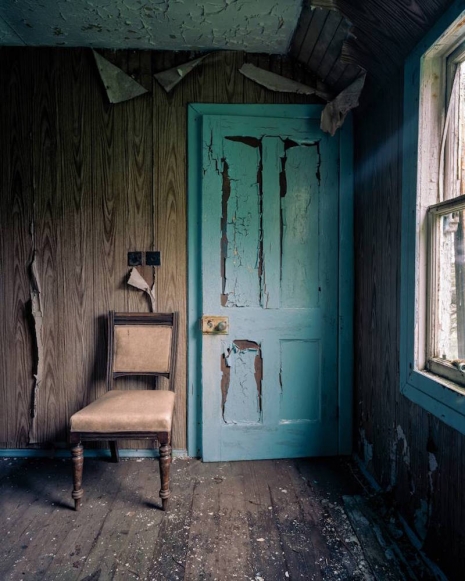
‘Waiting Room.’
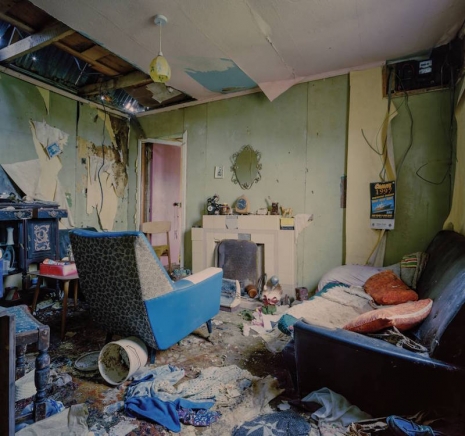
‘Blue Chair.’
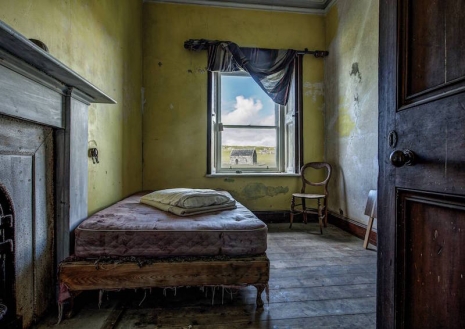
‘Bedroom and Chapel.’
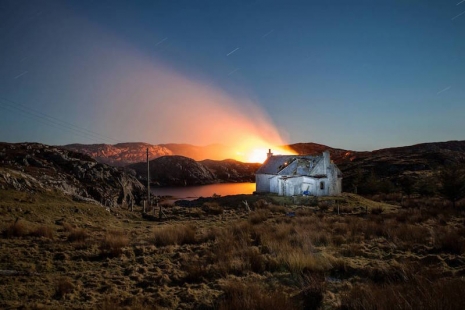
‘Peat Fire.’

‘Tin and Stone.’
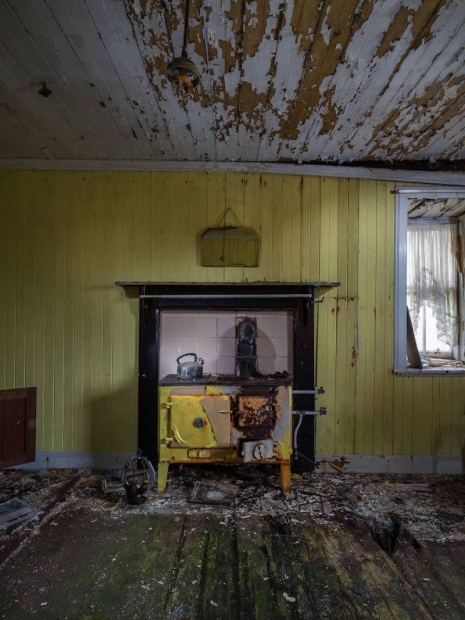
‘Parallel Lines.’
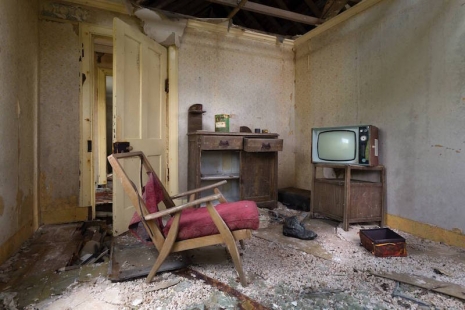
‘TV Set.’
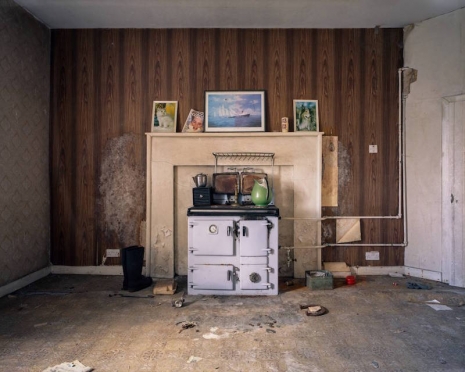
‘The Dog, the Cat and the Bird.’

‘Big Blue Caravan.’

‘Green Room.’

‘No Job Too Small.’

‘Nobody’s Home.’
H/T It’s Nice That, BBC, Flashbak and The Flying Monk.

‘Waiting Room.’

‘Blue Chair.’

‘Bedroom and Chapel.’

‘Peat Fire.’

‘Tin and Stone.’

‘Parallel Lines.’

‘TV Set.’

‘The Dog, the Cat and the Bird.’

‘Big Blue Caravan.’

‘Green Room.’

‘No Job Too Small.’

‘Nobody’s Home.’
H/T It’s Nice That, BBC, Flashbak and The Flying Monk.
Labels:
buzzcocks,
Photography
Wednesday, October 19, 2016
Tuesday, October 18, 2016
Noam Chomsky Unravels the Political Mechanics Behind His Gradual Expulsion From Mainstream Media

from AlterNet
The prolific author and acclaimed MIT professor is never featured on major networks.
Ralph Nader and leading linguist Noam Chomsky engaged in a much anticipated discussion in early October on Ralph Nader Radio Hour. The two raised questions about changing the media narrative in a totalitarian-like state, and how Chomsky got dismissed from the mainstream altogether.
"How often have you been on the op-ed pages of the New York Times?" Nader asked Chomsky.
For Chomsky, the last time was over a decade ago.
"[I was asked] to write about the Israeli separation wall, actually an annexation wall that runs through the West Bank and breaking apart the Palestinian communities... condemned as illegal by the World Court," Chomsky told Nader.
Chomsky would later pen a similar piece for CNN on the 2013 Israeli-Palestinian peace talks. But Chomsky has never been interviewed on the network; nor has he appeared on NBC, ABC or CBS.
"How about NPR and PBS, partially taxpayer-supported...more free-thinking and more tolerant [outlets]?" Nader wanted to know.
"I've been on 'Charlie Rose' two or three times," Chomsky told Nader, adding that he had a curious story about a particular Boston outlet for NPR based in Boston University.
"They used to have a program in their primetime news programs All Things Considered some years ago at 5:25... maybe once a week or so, a five-minute discussion with someone who had written a new book and there's a lot of pressure," Chomsky began.
NPR was going to allow Chomsky to present his 1989 book, Necessary Illusions: Thought Control in Democratic Societies.
"I got a call from the publisher telling me when I should tune in and I never listened [before], so I tuned in [and] there was five minutes of music... I started getting phone calls from around the country asking 'What happened to the piece?'" Chomsky remembered.
"I then got a call from the station manager in Washington who told me that she'd been getting calls and she didn't understand it because it was listed... she called back saying kind of embarrassed ... that some bigwig in the system had heard the announcement at five o'clock and had ordered it canceled," Chomsky explained.
The irony of Chomsky's media criticism being dismissed by the media is not lost on the former MIT professor, who remains in awe of America's level of censorship.
"Any one of the former Bush-Cheney warmongers like Paul Wolfowitz and John Bolton and others have gotten far more press after they've left federal positions; in the New York Times, the Wall Street Journal, the Washington Post," Nader said.
And unlike Chomsky, "They've been on television public television, NPR and they have a record of false statements; they have record of deception, they have record of pursuing policies are illegal under our Constitution, under international law and under federal statutes such as criminal invasion of Iraq and other adventures around the world," Nader pointed out.
But the media problem permeates other industries, like education and government.
"Now, a society that operates in a way where propaganda is not only emanating from the major media but it gets into our schools, the kind of courses are taught, the content of the history, is a society that's not going to be mobilized for its own survival, much less the survival of other countries whose dictators we have for decades supported to oppress their people," explained Nader.
Listen to Ralph Nader's full program with Noam Chomsky:
Labels:
media,
Noam Chomsky,
Ralph Nader,
Video
Monday, October 17, 2016
School of Life Monday:
POLITICAL THEORY - John Ruskin
John Ruskin was an art critic who believed the immorality of 19th century capitalism could be highlighted by one thing above all others: the ugliness of the environment.
Labels:
"school of Life",
John Ruskin,
Politics
Sunday, October 16, 2016
Saturday, October 15, 2016
Friday, October 14, 2016
Have Fun Friday
Someone stuck a Go-Pro on a Hot Wheels car
from Boing Boing

5MadMovieMakers revealed how they make their cool POV videos of Hot Wheels cars flying down tracks: a GoPro Hero affixed to Pharadox Hot Wheels Chassis.
They posted a picture of the rig designed by Raptor House Effects for others who want to give it a shot.
Labels:
gopro,
Hot Wheels
Thursday, October 13, 2016
Skating off the stage at CBGB's circa 1987
from my instagram
A photo posted by glen E. friedman Ⓥ (@glenefriedman) on
Labels:
CBGB's,
punk rock,
skateboarding
Wednesday, October 12, 2016
Tuesday, October 11, 2016
There's A Word for Buying Books and Not Reading Them
from "OZY"
WHY YOU SHOULD CARE.
Because you won’t read this in a book … if you’re not reading your books.
Part of an occasional series on unusual words we wish we had in English.
WHY YOU SHOULD CARE.
Because you won’t read this in a book … if you’re not reading your books.
Part of an occasional series on unusual words we wish we had in English.
Nick Carraway slinks away from Jay Gatsby’s party. In the library he comes across a drunken, bespectacled fat cat who starts going off about the books lining the walls. “They’re real,” he slurs, pointing to them. “What thoroughness! What realism! Knew when to stop too — didn’t cut the pages. But what do you want? What do you expect?” Uncut pages! If you know how books used to be manufactured, this means one thing and one thing only: Gatsby wasn’t much of a reader. After all, until they’re cut, book pages can’t be turned.
Collecting books and not reading them is, shall we say, textbook behavior. At least for some of you, and you know who you are. Suffering from the condition of racking up book purchases of $100, $200 or $1,000 without ever bending a spine? There’s a Japanese word for you.
Prognosis: terminal. Stats reveal that e-reading doesn’t hold a candle to the joy of reading a physical book. Although e-book sales jumped 1,260 percent between 2008 and 2010, 2.71 billion physical books were sold in the U.S. alone in 2015, according to Statista. That’s compared with the 1.32 billion movie tickets sold in the U.S. and Canada. As if every American were reading an average of more than eight books annually.
Certainly, it’s unlikely you’re going to hear the word tsundoku on the subway. But in a language where there are words for canceling an appointment at the last minute and the culture-specific condition of adult male shut-in syndrome, how can you be surprised? Other, similar words like tsūdoku (read through) and jukudoku (reading deeply) are in praise of sitting down with a book (doku means “to read”). But we think tsundoku is particularly special: Oku means to do something and leave it for a while, says Sahoko Ichikawa, a senior lecturer at Cornell University, and tsunde means to stack things.
We all know one or two people who have this expensive but arguably harmless addiction (harmless unless your surname is Collyer, that is). We might even look in the mirror and see it. Bibliotherapists Ella Berthoud and Susan Elderkin used to suffer from tsundoku, Elderkin says, before they began to cull their collections. They had a bad case: They stored books in poorly ventilated bathrooms and under the sink, “places where books, frankly, do not want to be,” Elderkin says. Perhaps there’s a reason for those of us still afflicted. Books can be a status symbol. Sometimes collectors acquire for nostalgia’s sake, says Susan Benne, executive director of the Antiquarian Booksellers’ Association of America. Perhaps they read the books in childhood or adolescence, or the book becomes a symbol of a certain time in their life. Let’s be real: It is probably The Catcher in the Rye.
Who could blame the Japanese for having this word? Murakami books are awfully pretty, but those suckers can be long. Does anyone really read them?
Labels:
Books,
collecting,
vocabulary,
words
Monday, October 10, 2016
School of Life Monday
History: Consumerism
and The $265 Black Flag T-Shirt mention
In the Wall Street Journal
It’s only very recently in history that we’ve been able to buy more than the bare necessities. Can the history of consumption guide us to a wiser future?
from THE WALL STREET JOURNAL
Page ONE - 7 October 2016

Sunday, October 9, 2016
Saturday, October 8, 2016
Classic Marvel comics covers remixed to showcase old school rap legends
from Dangerous Minds:
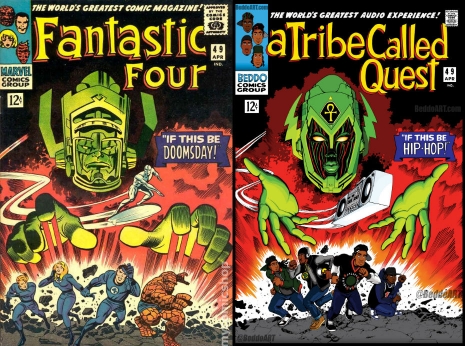
A Tribe Called Quest, reworking of Fantastic Four #49 (April 1966), “If This Be Doomsday!”
The Silver Surfer must choose between his master and the Earth

A Tribe Called Quest, reworking of Fantastic Four #49 (April 1966), “If This Be Doomsday!”
The Silver Surfer must choose between his master and the Earth
Not long ago an artist going by the name Beddo released a whole bunch of lovingly recreated classic Marvel covers featuring some of the greatest rap artists of the 1980s and 1990s. Beddo says that there are more on the way, and it is devoutly to be hoped that he stands by his word.

Notorious B.I.G., reworking of Spider-Man #50 (July 1967), “Spiderman No More!’
First appearance of Kingpin

Tupac, reworking of X-Men #141 (January 1981), “Days of Future Past”
First appearance the Future X-Men

Public Enemy, reworking of New Mutants #87 (March 1990), “A Show of Power!”
First full appearance of the Mutant Liberation Front
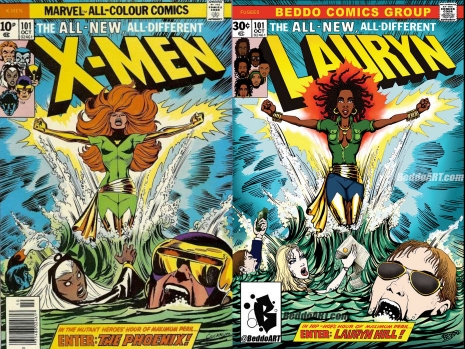
Lauryn Hill, reworking of X-Men #101 (October 1975), “Like a Phoenix, from the Ashes”
First appearance of Jean Gray as Phoenix

Rakim, reworking of Iron Man #128 (November 1979), “Demon in a Bottle”
Tony Stark deals with his alcoholism
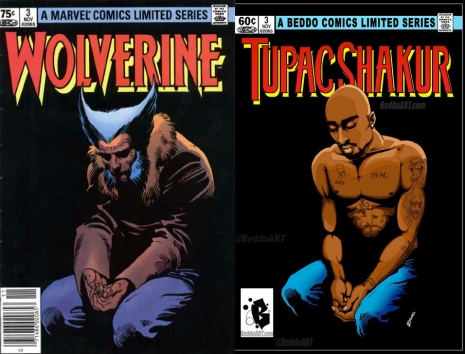
Tupac, reworking of Wolverine Limited Series #3 (November 1982), “Loss”
Death of Yukio

Wu-Tang Clan, reworking of Marvel Super Heroes Secret Wars #1 (May 1984), “The War Begins”
Big clusterfuck in outer space with just about all the Marvel heroes
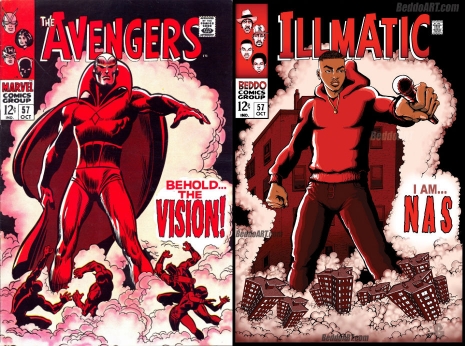
Nas, reworking of Avengers #57 (October 1968), “Behold the Vision!”
First appearance of Vision
While researching this post I came across this clever reworking of Avengers #57starring John Cage, by artist Clinton Reno for a performance at the Available Light Theater in Columbus, Ohio:
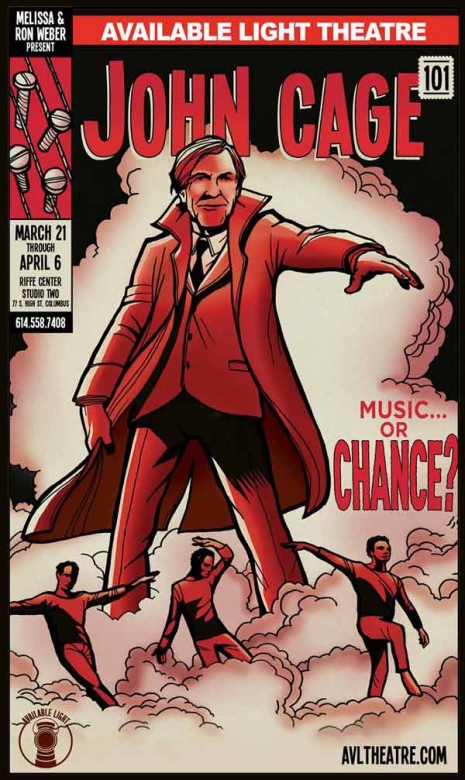

Notorious B.I.G., reworking of Spider-Man #50 (July 1967), “Spiderman No More!’
First appearance of Kingpin

Tupac, reworking of X-Men #141 (January 1981), “Days of Future Past”
First appearance the Future X-Men

Public Enemy, reworking of New Mutants #87 (March 1990), “A Show of Power!”
First full appearance of the Mutant Liberation Front

Lauryn Hill, reworking of X-Men #101 (October 1975), “Like a Phoenix, from the Ashes”
First appearance of Jean Gray as Phoenix

Rakim, reworking of Iron Man #128 (November 1979), “Demon in a Bottle”
Tony Stark deals with his alcoholism

Tupac, reworking of Wolverine Limited Series #3 (November 1982), “Loss”
Death of Yukio

Wu-Tang Clan, reworking of Marvel Super Heroes Secret Wars #1 (May 1984), “The War Begins”
Big clusterfuck in outer space with just about all the Marvel heroes

Nas, reworking of Avengers #57 (October 1968), “Behold the Vision!”
First appearance of Vision
While researching this post I came across this clever reworking of Avengers #57starring John Cage, by artist Clinton Reno for a performance at the Available Light Theater in Columbus, Ohio:

Labels:
Biggie Smalls,
comic books,
Marvel Comics,
tupac Shakur,
wu-tang clan,
X-Men
Subscribe to:
Comments (Atom)


























